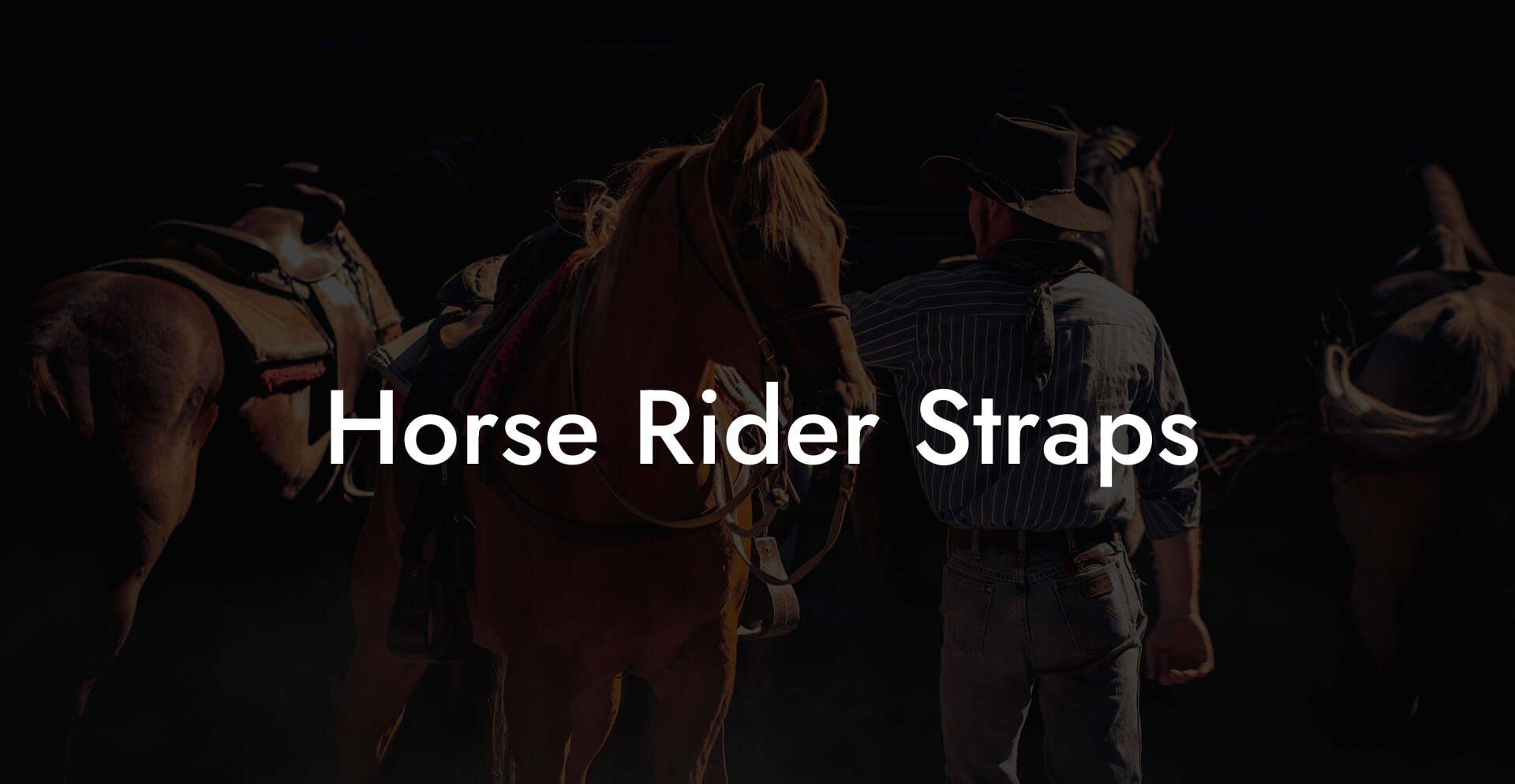There’s nothing quite like strapping on your gear with the swagger of a modern equestrian—where style meets safety and every detail counts. Horse rider straps are not just a functional element of your riding kit; they’re a statement of precision, innovation, and a nod to the spirited community of Gen-Z and millennial riders who crave both performance and flair. Get ready to embark on an in-depth journey into the world of horse rider straps, from their design and technology to maintenance tips that keep your gear looking fresh and feeling secure.
Quick Links to Useful Sections
- What Are Horse Rider Straps?
- The Evolution of Horse Rider Straps: From Basic to Brilliant
- Key Components of Horse Rider Straps
- Selecting the Perfect Rider Straps
- Assess Your Riding Style
- Material Matters
- Adjustability and Fit: The Hallmarks of a Great Strap
- Rider Straps and Horse Safety: A Dual Impact
- Innovative Technologies in Modern Rider Straps
- Smart Straps with Embedded Sensors
- Eco-Friendly and Sustainable Manufacturing
- Maintenance and Care: Keeping Your Straps Riding-Ready
- Cleaning and Washing
- Storage Tips
- Regular Inspections and Repairs
- Style and Aesthetics: Making a Statement on Horseback
- DIY Modifications and Upgrades for the DIY Rider
- Customizing for Comfort
- Adding Personal Flair
- Tech Upgrades
- Integrating Rider Straps with Other Equestrian Gear
- Safety and Performance: Enhancing Your Riding Experience
- Resources and Community Support: Your Next Steps
- Mastering the Art of horse care: Integrative Tips for a Harmonious Riding Experience
- Regular grooming and health Checks
- Balanced nutrition and Hydration
- Training and Mental Stimulation
- Collaborative Communication
- FAQs About Horse Rider Straps
- Your Journey to Next-Level Equestrian Adventure
What Are Horse Rider Straps?
Horse rider straps are a critical component of equestrian gear designed to securely fasten, support, and distribute the rider’s weight during various riding disciplines. Whether you’re hitting the jumps, cruising on a trail, or competing in dressage, these straps protect you and ensure you remain connected to your horse in the most comfortable and reliable way possible.
Often constructed from high-performance materials like reinforced nylon, leather, or advanced synthetics, rider straps are engineered to resist wear, tear, and the elements. They feature adjustable buckles and clips that cater to the modern rider’s need for a personalized fit, ensuring that your gear molds perfectly to your body and riding style. In today’s fast-paced world, where aesthetics and practicality go hand in hand, rider straps have evolved far beyond their utilitarian roots—they now incorporate sleek designs and even tech-enhanced features that speak to the dynamic lifestyle of younger riders.
The Evolution of Horse Rider Straps: From Basic to Brilliant
In the early days of horseback riding, gear was simple and often purely functional. As equestrian sports and recreational riding evolved, so did the technology and design behind essential accessories like rider straps. Modern equestrian enthusiasts demand equipment that not only performs exceptionally under pressure but also reflects a blend of fashion, innovation, and sustainable practices.
Today’s rider straps serve as a testament to that evolution. Gone are the days of one-size-fits-all straps that only hinted at customization. Contemporary designs come equipped with adjustable features, ergonomic contours, and even smart materials that adapt according to your movement and environmental conditions. For riders in the digital age, these straps are a must-have, merging utility with an aesthetic edge that resonates with a crowd that values both high-tech gear and green manufacturing.
The blend of advanced materials with cutting-edge design has led to straps that offer superior grip, unparalleled durability, and a look that underscores your modern equestrian spirit. Whether you’re racing against the clock in a competition or enjoying a serene trail ride, rider straps are now as much about performance as they are about personal style.
Key Components of Horse Rider Straps
Understanding the anatomy of a rider strap can help you make an informed decision when selecting gear that meets your needs. Let’s break down the essential components:
- Adjustable Buckles: These provide flexibility, allowing you to fine-tune the fit for both comfort and safety. Modern buckles are user-friendly, with intuitive designs that even a beginner can master.
- High-Performance Materials: Whether it’s durable nylon, supple leather, or innovative synthetic fibers, the quality of the material directly impacts the strap’s strength and longevity.
- Reinforced Stitching: Double or triple stitching ensures that your straps can handle rigorous use without fraying or breaking, even in the toughest conditions.
- Padding and Ergonomics: Integrated cushioning in key areas provides extra comfort during long rides, reducing pressure points and potential chafing.
- Security Features: Some straps now incorporate anti-slip technology and even biometric sensors that alert you to any misalignment or wear, ensuring maximum security.
Each of these components works in synergy to deliver a rider strap that not only meets performance standards but also aligns seamlessly with the demands of contemporary equestrians.
Selecting the Perfect Rider Straps
In a market brimming with options, the quest to find the perfect horse rider straps can feel like a treasure hunt. The key is to balance performance, comfort, aesthetics, and, yes, the vibe that appeals to your inner Gen-Z rebel or millennial minimalist.
Assess Your Riding Style
Your riding discipline plays a big role in determining the type of straps that will best suit you. Are you a competitive jumper, a leisurely trail rider, or perhaps a dressage aficionado? Each practice might require subtle variations in strap design:
- Jumping and Eventing: Look for straps that offer excellent stability and impact resistance, ensuring that sudden movements don’t compromise control.
- Trail Riding: Prioritize comfort and adjustability, as prolonged use on varied terrains calls for gear that prevents chafing and provides consistent support.
- Dressage and Precision Riding: Straps that offer a sleek profile and refined aesthetic are ideal, alongside functionality that supports intricate movements.
It’s also important to consider your body type and personal comfort preferences. Rider straps that offer multiple adjustment points provide a more tailored fit, which is crucial for both performance and injury prevention.
Material Matters
The choice of material can be a game changer. Top choices for rider straps include:
- Nylon: Known for its high tensile strength and resistance to abrasion, nylon is often favored for its durability and low maintenance.
- Leather: A classic favorite that not only ages well but also provides exceptional comfort with a bit of a vintage aesthetic appeal.
- Synthetic Fibers: Modern materials are pushing the envelope in terms of lightness, strength, and even environmental sustainability. These often incorporate moisture-wicking and thermal regulating technologies.
Choosing the right material is about balancing your performance needs with your aesthetic sensibilities. For riders who are eco-conscious, exploring sustainably sourced options can also make a big difference.
Adjustability and Fit: The Hallmarks of a Great Strap
The magic of horse rider straps lies in their adjustability. This is where most gear wins or loses points among riders who demand a perfect blend of form and function.
Advanced adjustable systems allow riders to make micro-adjustments for a snug and secure fit, minimizing movement and potential distractions during a ride. Whether you’re a seasoned pro or a weekend warrior, having straps that conform to your body’s contours ensures both comfort and safety.
Modern designs have simplified the adjustment process, featuring intuitive clip systems and ergonomic guides that help you lock in the desired tension without hassle. Imagine a strap that adapts to you like your favorite pair of jeans—only with way more technical wizardry!
Rider Straps and Horse Safety: A Dual Impact
Safety is paramount in horseback riding, and rider straps play a critical role in maintaining secure contact between you and your horse. A well-fitted strap distributes pressure evenly, reducing the risk of injury and ensuring that you remain balanced regardless of sudden movements.
A notable feature in many modern rider straps is their shock-absorption capability, which acts as a buffer during jumps or abrupt stops. This is not only beneficial for the rider but also minimizes undue strain on the horse. After all, a secure rider is a harmonious rider, and harmony in the saddle directly translates to a happier, more engaged horse.
In addition, some high-end straps incorporate reflective materials or neon accents to enhance visibility during evening rides—a nod to our tech-savvy, safety-minded riders who aren’t afraid to push boundaries while staying secure.
Innovative Technologies in Modern Rider Straps
The evolution of rider straps doesn’t stop at materials and design; technology is taking center stage in revolutionizing equestrian gear. Imagine straps that do more than just secure you to your saddle—they actively monitor your movement and provide feedback.
Smart Straps with Embedded Sensors
Some of the latest innovations include smart straps equipped with embedded sensors, designed to assess factors like tension, movement, and even biometric data. This real-time monitoring allows riders to adjust their positioning on the fly, improving balance and reducing unnecessary strain.
These sensor-equipped straps can connect to your smartphone via Bluetooth, offering a digital interface that tracks your performance and provides tailored insights. Whether you’re training for competitions or just trying to perfect your posture, these technological marvels offer feedback that traditional gear simply cannot.
Eco-Friendly and Sustainable Manufacturing
In a world where environmental consciousness is paramount, many manufacturers are shifting toward sustainable production methods. Modern rider straps are increasingly being made with recycled materials, biodegradable synthetics, and eco-friendly dyes that do not compromise on durability or aesthetic appeal.
For the eco-conscious rider, choosing sustainably produced straps not only contributes to the well-being of the planet but also sets a trend for ethical equestrian gear that resonates with the values of today’s generation.
Maintenance and Care: Keeping Your Straps Riding-Ready
Even the most advanced rider straps require proper care to maintain their performance and extend their lifespan. Taking proper care of your gear is as important as selecting it in the first place.
Cleaning and Washing
Depending on the material, regular cleaning can prevent the build-up of dirt, sweat, and debris that can weaken the straps over time. For nylon and synthetic straps, a gentle machine wash or a quick hand wash with mild detergent is usually sufficient. Leather straps, on the other hand, require more delicate care—using a leather cleaner and conditioner will keep them supple and resistant to cracking.
Storage Tips
When you’re not riding, store your straps in a cool, dry place away from direct sunlight. Hanging them up or laying them flat can help prevent creasing and stress on the stitching. For riders on the go, investing in a dedicated gear bag will protect your straps and other equipment from the daily grind.
Regular Inspections and Repairs
Just like any piece of technical equipment, periodic inspections are key to ensuring safety. Look for signs of wear such as frayed seams or compromised buckles. Many modern straps are designed with replaceable parts, so a quick DIY fix might be enough to keep your gear in top condition. If in doubt, consulting with a professional or the manufacturer’s support team could save you from bigger issues down the road.
Maintaining your rider straps not only preserves their functionality but also ensures that you’re always riding with confidence, knowing that every adjustment has been meticulously designed for your safety and comfort.
Style and Aesthetics: Making a Statement on Horseback
Being a rider isn’t just about performance—it’s also about self-expression. Modern rider straps come in a myriad of colors, textures, and designs that allow you to tailor your equestrian look to your personal style. From minimalist, understated designs to bold, vibrant patterns, there’s a strap for every personality.
Many riders now see their gear as an extension of themselves; a carefully chosen strap not only enhances your performance but also elevates your overall look in the arena. Whether you prefer classic leather with timeless appeal or futuristic synthetics that scream innovation and flair, your rider straps can be the final touch that sets you apart.
Trendy details such as embossed logos, reflective accents, and even customizable options have redefined what equestrian chic can be. It’s a world where function and fashion coexist—ensuring that while you’re riding safely, you’re also making a powerful style statement.
DIY Modifications and Upgrades for the DIY Rider
For those who love to tinker, the world of DIY modifications offers a creative avenue to customize your horse rider straps even further. Whether it’s adding extra padding, re-stitching worn areas, or incorporating personalized embellishments, a little ingenuity can go a long way.
Customizing for Comfort
Experiment with adding removable cushioning or different types of lining to areas that tend to get extra pressure. Many riders have found that a small modification can significantly improve comfort during long rides.
Adding Personal Flair
Personalize your straps with patches, embroidery, or even glow-in-the-dark elements that reflect your personality. DIY projects like these not only result in gear that’s perfectly attuned to your needs but also create conversation starters among fellow riders.
Tech Upgrades
For the tech-savvy, consider attaching small sensor kits available in specialty stores. These modules can monitor strain and movement, offering a glimpse into your riding metrics and further enhancing your training sessions.
Embrace your inner innovator and experiment with modifications that cater to your specific riding habits while also giving your gear that personal touch that truly sets you apart.
Integrating Rider Straps with Other Equestrian Gear
Horse rider straps are just one piece of the equestrian puzzle. When integrated with other forms of gear—such as helmets, bridles, and riding boots—they work in harmony to create a cohesive riding system that maximizes both safety and performance.
The art of combining these elements lies in choosing coordinating designs, materials, and even color schemes. A well-matched set of gear reinforces your confidence in the saddle while also minimizing distractions. For instance, lightweight, breathable straps coupled with a technologically advanced helmet ensure that you remain agile, focused, and stylish throughout your ride.
Modern equestrians understand that the details matter—from the precise calibration of a smart strap to the impeccable finish of a custom leather bridle. It’s this level of attention to detail that sets apart the serious rider from the casual enthusiast.
Safety and Performance: Enhancing Your Riding Experience
At its core, the primary purpose of horse rider straps is to deliver unyielding safety and performance. An ideal pair of straps not only secures you during unpredictable movements but also anticipates your needs with intuitive adjustability and support systems.
Advanced strap designs help in reducing the risk of injury by distributing pressure evenly and minimizing slippage. From shock absorption to ergonomic contours that support your core, these features are meticulously engineered for optimum performance. The fusion of safety and style means you’re always prepared to take on that challenging course or navigate through a wild, adventurous trail with assurance.
Ultimately, investing in quality rider straps is an investment in your riding journey—a guarantee that every ride is backed by a commitment to safety, comfort, and technological innovation.
Resources and Community Support: Your Next Steps
Navigating the world of horse rider straps can be as thrilling as it is overwhelming. Fortunately, the equestrian community is a treasure trove of insights, tips, and support. Whether you’re a seasoned professional or just starting out, there are numerous resources available:
- Online Forums and Social Media Groups: Platforms like Instagram, Reddit, and dedicated equestrian forums are bustling with discussions on the latest gear innovations, DIY modifications, and personal reviews. Join groups that share your passion for equestrian sports and never hesitate to ask for advice.
- YouTube Tutorials: Visual learners can benefit from countless tutorials on strap maintenance, DIY upgrades, and riding tips from seasoned professionals. They offer step-by-step guides and real-life demonstrations that can simplify even the most complex modifications.
- Local Equestrian Clubs: These clubs are great for networking with like-minded riders, trying out the latest gear, and even attending workshops and clinics on riding safety and equipment maintenance.
- Product Reviews and Blogs: Keep an eye on well-respected equestrian blogs and review sites for in-depth analyses of new products and trends. These resources provide honest feedback and often include comparisons between different brands and models.
- Manufacturer Support: Many companies that produce rider straps offer customer support, maintenance guides, and even warranty services to ensure you get the most out of your purchase.
By tapping into these resources, you can continuously refine your gear, stay ahead of new trends, and ultimately safeguard your riding adventures with confidence and a touch of personal style.
Mastering the Art of horse care: Integrative Tips for a Harmonious Riding Experience
In the realm of equestrian activities, gear is only one part of the equation; the well-being of your horse is equally important. A holistic approach to horse riding not only includes using high-quality rider straps but also a commitment to integrative horse care.
Just as you invest time in selecting the perfect straps, consider these integrative tips to foster a closer bond with your equine partner:
Regular grooming and health Checks
Routine grooming sessions help build trust while also allowing you to monitor your horse’s physical condition. Look for any signs of discomfort, skin issues, or potential injuries that may affect their performance.
Balanced nutrition and Hydration
A healthy horse is a happy horse. Ensure their diet is carefully balanced with enough protein, vitamins, and minerals, and always provide fresh water to keep them hydrated before, during, and after rides.
Training and Mental Stimulation
Incorporate varied training exercises and mental challenges into your horse’s routine. Not only does this keep them physically fit, but it also nurtures cognitive function and encourages a well-rounded partnership during rides.
Collaborative Communication
Whether through subtle gestures or vocal cues, developing a reliable communication system with your horse can significantly enhance both safety and performance. When your rider straps and other gear support your riding, a harmonious relationship with your horse becomes the foundation of success.
Embrace an integrative approach to horse care, and you’ll find that every ride becomes a deeper, more meaningful exploration of trust, unity, and the sheer joy of equestrian life.
FAQs About Horse Rider Straps
We know you have questions, and we’re here to help you get answers on all things horse rider straps. Check out these frequently asked questions below:
1. What exactly are horse rider straps used for?
Horse rider straps are essential equestrian accessories designed to secure the rider in place, distribute weight evenly, and provide comfort and safety during rides. They’re used across various riding disciplines to enhance performance and prevent injuries.
2. How do I choose the right straps for my riding style?
Consider factors like your specific riding discipline, the type of materials you prefer (nylon, leather, synthetic), and the desired level of adjustability. Reading reviews and seeking recommendations from fellow riders can also help you make an informed decision.
3. Are there any smart technologies integrated into modern rider straps?
Absolutely! Many modern straps come with embedded sensors that monitor tension and movement. These “smart straps” can sync with your smartphone, offering real-time insights into your riding posture and performance.
4. How often should I inspect my straps for wear and tear?
It’s a good idea to inspect your straps regularly—ideally before every ride. Check for frayed seams, worn-out buckles, or any signs of damage, and perform maintenance as needed to ensure optimal safety.
5. What cleaning methods are best for maintaining rider straps?
The cleaning process depends on the material. For nylon and synthetic straps, a gentle hand wash or machine wash with mild detergent works well. Leather straps require special leather cleaners and conditioners to maintain their suppleness and longevity.
6. Can I modify my straps for a better fit?
Many riders enjoy DIY modifications such as adding custom padding or unique embellishments. However, always ensure that any modifications do not compromise the structural integrity and safety features of the straps.
7. Where can I find reviews and comparisons of different rider straps?
Check out equestrian blogs, YouTube review channels, online forums, and social media groups where experienced riders share their insights, tips, and comparisons on the latest gear.
8. Are eco-friendly rider straps as durable as traditional ones?
Yes, eco-friendly straps made from recycled or biodegradable materials are designed to meet high-performance standards without compromising on durability or aesthetics.
9. How do rider straps contribute to better horse care?
Well-fitted and secure rider straps enhance your balance and stability. A confident rider ensures a smoother ride, which indirectly contributes to a more relaxed and comfortable experience for your horse.
10. Can beginner riders benefit from advanced straps with technology?
Definitely! Smart straps and adjustable designs can help beginners improve their posture and balance, fostering better riding habits from the very start.
Your Journey to Next-Level Equestrian Adventure
From the innovation of smart sensor-embedded straps to the timeless charm of handcrafted leather, the world of horse rider straps is a vibrant blend of art, technology, and performance. With every adjustment, every secure click of the buckle, you’re stepping further into a realm where every ride is not just a journey but an adventure.
Embrace the fusion of style and safety that modern rider straps offer, knowing that your gear is more than just equipment—it’s a partner that supports every leap, every sprint, and every graceful trot you share with your equine companion. This isn’t just about riding; it’s about crafting experiences where every detail counts and every ride is a story waiting to be told.
So strap in (literally) and explore the endless possibilities that await in the realm of equestrian innovation. Whether you’re fine-tuning your form with smart technology, customizing your gear to match your adventurous spirit, or simply reveling in the artistry of quality craftsmanship, your journey into next-level riding begins now.
Let your rider straps be a reminder that in the world of horse riding, every ride is a new chapter—one filled with passion, innovation, and a deep love for the sport. Step into the saddle with confidence, embrace the technology, honor the tradition, and ride on towards your best equestrian adventures yet.













